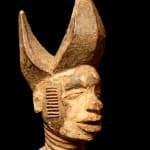Idoma Seated Ekwotame Sculpture, 20th Century CE
Wood
12
DA.410 (LSO)
Further images
This ornate figure of a squatting female was made by the Idoma people of Nigeria, and possesses a combination of traditional and progressive characteristics. The pale colour is believed to...
This ornate figure of a squatting female was made by the Idoma people of Nigeria, and possesses a combination of traditional and progressive characteristics. The pale colour is believed to represent the spirit world, and is something that is shared with the neighbouring Igbo people. The vertical keloid scarifications on the temples are also traditional. The ringed neck (possibly representing jewellery and thus wealth) is atypical for the group, as is the astonishingly extravagant coiffure. While unusual enough to defy certainty in attribution, it is probably an Ekwotame sculpture, which represent ancestors and were placed near bodies of the deceased in order to celebrate their ancestry and passing.
The Idoma are one of several tribal groups native to the Benue and Niger River deltas. They are said to have been descended from the semi-mythical Akpoto people, and act as traders between the inhabitants of the deltas and inland groups. Their artworks tend to represent females, and are linked to femininity/fecundity.
This is a striking and powerful work of Idoma art.
The Idoma are one of several tribal groups native to the Benue and Niger River deltas. They are said to have been descended from the semi-mythical Akpoto people, and act as traders between the inhabitants of the deltas and inland groups. Their artworks tend to represent females, and are linked to femininity/fecundity.
This is a striking and powerful work of Idoma art.







